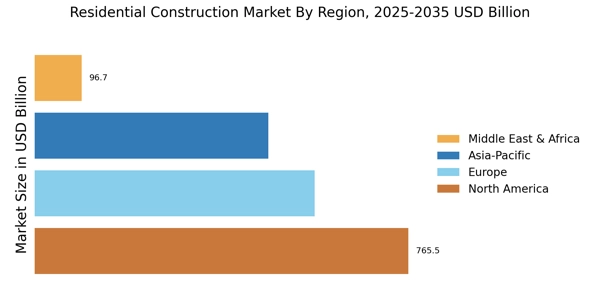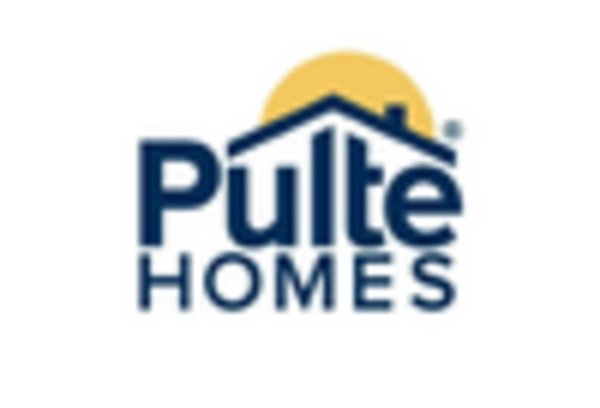Demographic Shifts
Demographic changes are significantly impacting the Residential Construction Market, as varying age groups and lifestyle preferences shape housing demand. The millennial generation, now entering their prime home-buying years, is driving demand for modern, flexible living spaces that accommodate remote work and urban lifestyles. Additionally, the aging population is seeking accessible housing options, prompting developers to consider multi-generational homes and age-friendly designs. Recent data indicates that nearly 30% of new homes are being designed with features catering to older adults, reflecting this demographic shift. As these trends continue to evolve, they will likely influence the types of residential projects being developed, thereby reshaping the Residential Construction Market to meet the diverse needs of the population.
Urbanization Dynamics
The ongoing trend of urbanization is a critical driver in the Residential Construction Market, as more individuals migrate to urban centers in search of employment and lifestyle opportunities. This influx of population into cities creates a heightened demand for housing, particularly in metropolitan areas. Recent statistics suggest that urban areas are expected to see a population increase of approximately 1.5 billion by 2030, necessitating the construction of millions of new residential units. Consequently, developers are focusing on high-density housing solutions, such as apartments and condominiums, to accommodate this growing population. This shift not only influences the types of residential projects being undertaken but also impacts urban planning and infrastructure development, thereby shaping the future landscape of the Residential Construction Market.
Sustainability Initiatives
The increasing emphasis on sustainability within the Residential Construction Market is driving demand for eco-friendly building materials and energy-efficient designs. Homebuyers are increasingly prioritizing sustainable features, such as solar panels and energy-efficient appliances, which are becoming standard in new constructions. According to recent data, homes built with sustainable practices can command a premium price, often exceeding 10 to 15% over traditional homes. This trend is not merely a passing phase; it reflects a broader societal shift towards environmental responsibility. As regulations tighten around carbon emissions and energy consumption, builders are compelled to adopt sustainable practices, thereby reshaping the Residential Construction Market. The integration of green certifications and energy-efficient technologies is likely to become a key differentiator in the competitive landscape.
Technological Advancements
Technological integration is revolutionizing the Residential Construction Market, enhancing efficiency and reducing costs. Innovations such as Building Information Modeling (BIM) and prefabrication techniques are streamlining the construction process, allowing for faster project completion and improved accuracy. Data indicates that the adoption of these technologies can reduce construction time by up to 30%, significantly impacting project timelines and budgets. Furthermore, smart home technologies are increasingly being incorporated into new builds, appealing to tech-savvy consumers. This trend not only enhances the functionality of homes but also aligns with the growing demand for automation and connectivity. As technology continues to evolve, its role in shaping the Residential Construction Market is expected to expand, potentially leading to new business models and opportunities.
Government Policies and Incentives
Government policies and incentives play a pivotal role in shaping the Residential Construction Market. Various initiatives aimed at promoting affordable housing and sustainable development are influencing construction practices and investment decisions. For instance, tax credits and grants for energy-efficient home improvements are encouraging builders to adopt greener technologies. Additionally, zoning laws and land-use regulations are being revised to facilitate the construction of new residential projects, particularly in high-demand areas. Data shows that regions with supportive government policies experience a higher rate of new housing starts, indicating a direct correlation between policy frameworks and market activity. As governments continue to prioritize housing affordability and sustainability, their influence on the Residential Construction Market is likely to intensify.


















Leave a Comment